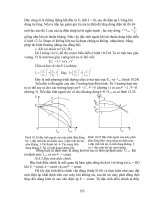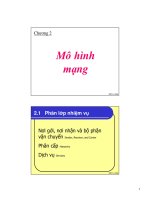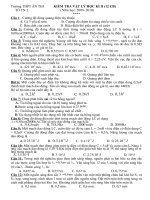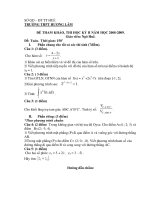Molecular Biotechnology-Lession 2: Recombinant DNA technology docx
Bạn đang xem bản rút gọn của tài liệu. Xem và tải ngay bản đầy đủ của tài liệu tại đây (1.5 MB, 54 trang )
Recombinant DNA technology
(Gene cloning, genetic engineering)
VIETNAM NATIONAL UNIVERSITY AT HO CHI MINH CITY
INTERNATIONAL UNIVERSITY
Tran Ngoc Duc, PhD
2. Prokaryotic and eukaryotic genes
3. Vectors
4. Cloning a gene
5. Transformation technology
6. Detection of the cloned gene/products
1. Introduction
1/6
Introduction
Glofish is the first
transgenic animal
approved to be
consumed by
human in the USA
The insertion of
different constructs
of GFP into the
fish genomes to
give different
green colors
The idea for recombinant DNA was first proposed by Peter
Lobban, a graduate student of Prof. Dale Kaiser in the
Biochemistry Department at Stanford University Medical School.
The first publications describing the successful production and
intracellular replication of recombinant DNA appeared in 1972
and 1973. Stanford University applied for a US patent on
recombinant DNA in 1974, listing the inventors as
Stanley N. Cohen and Herbert W. Boyer; this patent was
awarded in 1980.
The first licensed drug generated using recombinant DNA
technology was human insulin, developed by Genentech and
Licensed by Eli Lilly and Company
( />
Applications of recombinant biotechnology
Recombinant human insulin
Recombinant human growth hormone
Recombinant human blood clotting factor III
Recombinant hepatitis B vaccine
Golden rice
Herbicide resistant crop
Insecticide resistant crop
2/6
Prokaryotic and
eukaryotic genes
Prokaryotic
Most prokaryote require only one single RNA polymerase for
all types, which is different from eukaryote requiring 3
different RNA polymerase
Genes are usually
found grouped
together in
operons, which are
group of related
genes for a
metabolic pathway
under a single
promoter
(regulatory region)
lacZ encodes β-galactosidase
(LacZ), an intracellular enzyme that
cleaves the disaccharide lactose into
glucose and galactose.
lacY encodes β-galactoside
permease (LacY), a membrane-
bound transport protein that pumps
lactose into the cell.
lacA encodes β-galactoside
transacetylase (LacA), an enzyme
that transfers an acetyl group from
acetyl-CoA to β-galactosides.
Intron: noncoding region, 40-10,000bp
Exon: coding region, 150-500bp
5’, 3’ UTR = flanking regions
Eukaryotic
Eukaryotic genes are more complex than prokaryotic genes
Vectors
Vector is a DNA molecule used as vehicle to transfer
and amplify a foreign genetic material into another cell
There are four types of vector:
o
Plasmids
o
Virus
o
Cosmids
o
Artificial chromosomes (BAC, YAC)
Depending the size of a transgene, a proper vector is
used
A typical plasmid
beta-lactamase
Origin of replication, multi-cloning site and
selectable marker are common to vectors
Self-replicating
Double stranded
Circular DNA
Independent
extrachromosomal DNA in
bacteria 1kb-500kb
Origin of DNA replication, ori
High (10-100) & low copy
plasmid (1-4)
Ampicillin
Kanamycin
Neomycin
Tetracycline
Streptomycin
Hygromycin
White blue screening
LacZ encode β-galactosidase
β-galactosidase cleave X-gal
( analog of lactose) to form 5-bromo-
4-chloro-indoxyl, which then
spontaneously dimerizes and
oxidizes to form a bright blue
insoluble pigment 5,5'-dibromo-4,4'-
dichloro-indigo
Bacteriophage lamda vector:
Can carry up to 25kbDNA
1000 time more efficient than a plasmid
A virus that can infect bacteria
Cloning in Lambda Vectors
1. Make a partial digest of DNA.
2. Ligate the DNA to the arms of the vector.
3. Package the DNA into phage particles using
premade mixes.
4. Screen and then amplify.
5. Store the library for future use as a plate lysate.
o
A combination of a plasmid and a
cos site (DNA sequence, 200bp
originally from lambda phage,
essential for packaging) which help
to transfer a plasmid into a phage
head
o
Can carry up to 52 kb DNA
o
Unlike plasmid, cosmid can also
packaged into a capsid since it
contains the cos site and so it can
be used for transduction
Cosmid
Yeast artificial chromosome (YAC):
o
To clone large piece of DNA
which can carry up to 2-3
MbDNA
o
Constructed from the
telomeric, centromeric, and
replication origin sequences
needed for replication in yeast
cells
TEL: The telomere which is located at each chromosome
end, protects the linear DNA from degradation by nucleases.
CEN: The centromere which is the attachment site for
mitotic spindle fibers, "pulls" one copy of each duplicated
chromosome into each new daughter cell.
ORI: Replication origin sequences which are specific
DNA sequences that allow the DNA replication machinery to
assemble on the DNA and move at the replication forks.
4/6
Cloning a gene
/>









